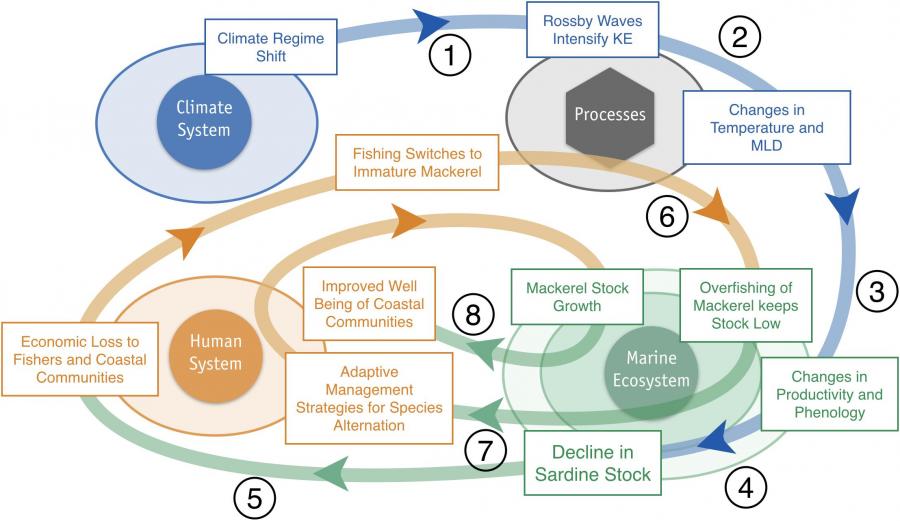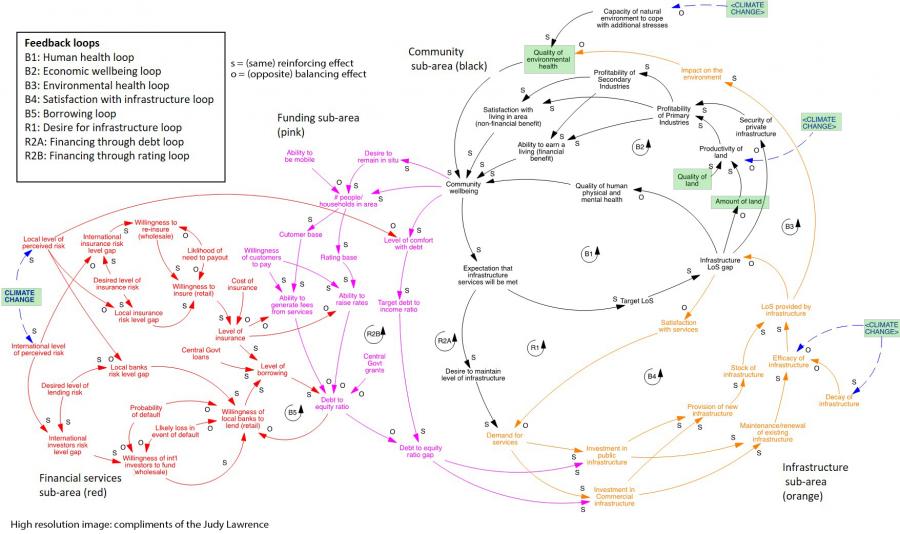
Due to the many interactions and feedbacks that occur in a complex system, changes in one part of a system can have cascading effects that cause sequential changes in the system’s other parts. Cascading effects can occur in many types of complex systems, including ecological, social, and socio-environmental ones. As described in the associated Explainer “Introduction to Cascades: Ecological, Social, and Socio-Environmental,” cascades of change occur in a networked system and are most likely to find momentum through specific enabling conditions that alter the network’s structure. Cascades can result in major changes to the system, i.e., regime shifts. Ecological cascades usually begin with some perturbation to a system of interacting species, such as extirpation or change in the abundance of a species, e.g., due to the loss of a top predator (Altieri et al. 2012) or the spread of a disease (Monk et al. 2022). Social cascades differ from ecological cascades in important ways because social systems involve human agency. They often result from the spread of a new behavior or norm, such as public pressure on firms to divest from fossil fuels. Socio-environmental cascades typically include economic and social upheavals triggered by climate change (Franzke et al. 2022) or cascading environmental hazards that have severe social consequences (e.g., droughts that leads to fires) (Brito et al. 2022).
This third lesson, in a three-part series, focuses on socio-environmental cascades, using climate change impacts that flow socio-economically and ecologically. Learners investigate the types of changes in governance that may better protect built infrastructure, humans, and economic systems. The first lesson of the series focuses on ecological systems and understanding how communities of species can experience cascading effects. The second lesson focuses on social cascades and investigates sectors ripe for cascades.
- Study how cascades flow sequentially through socio-environmental networks and how this phenomenon can influence built infrastructure, socio-economic systems, and human well-being.
- Understand the difference between positive (reinforcing) and negative (balancing or regulating) feedback loops.
- Identify enabling governance conditions that support damaging cascades.
- Consider changes in governance that may reduce the probability of cascades.
Have learners view Figure 1 above in this lesson (also available on Slide 2 of the Power Point). Ask them to identify the human behaviors/decisions that resulted in negative and positive impacts on them. Second, ask them to explain how negative impacts (socially) differ from negative feedbacks.
Socio-Environmental Cascades Associated with Climate Change (One, 50-minute class; extendable to 75 min.)
-
Prior to the Session: As preparation for the session, have learners read and take notes on: 1) the highlighted sections of the version of Lawrence et al. 2020 that is provided with the link below; and, 2) if learners did not complete Lesson 1 in the series, have them first read the SESYNC Cascades Explainer.
DocumentLawrence et al. 2020 – Highlighted.pdf (2.76 MB) -
The Hook: (5 min.) Give learners 2 minutes to complete the hook individually. As you show the image (PowerPoint slide 2), have several learners come up and trace the cascades that they identified.
-
Presentation: (10 min) Open the session with the PowerPoint, which reviews the basics of cascades and provides a few prompting questions to engage the learners. The last slide provides the directions for the below activity.
Document -
Interpreting the Causal Diagram: (5 min.) Divide the learners into groups of two. Using the causal diagram in Figure 2 of the Lawrence paper, answer the below questions. A higher-resolution version is linked below, and the figure is also in Slide 9 of the PowerPoint. Note to Instructor: You will want to share electronic versions of the figure and the questions to learners.
Image
- Identify the mechanism(s) by which climate change initiates a cascade in the infrastructure sub-area, the financial sub-area, and the community sub-area.
- Locate at least one positive feedback in the overall system and list the steps along that path. Note that a positive feedback is also called a reinforcing feedback and is caused by opposite effects.
- Identify at least two legacy effects arising from past governance.
- Identify at least one way in which impacts of climate change on an environmental component (in green) cascade to impacts on infrastructure.
-
Finding Examples in the Peer-Reviewed Literature (25 min.) Assign each group to one of the five narratives in Table 1 in the Lawrence paper (also in slide 10). These narratives explain how climate change can have cascading socio-environmental effects that begin by negatively impacting the performance of different forms of urban infrastructure. Instruct the learners to read the short narrative in Table 1 that they are assigned to; then, each group should:
Identify the environmental change associated with climate change that leads to the infrastructure problem; these differ among the narratives.
Using the peer-reviewed literature in your university’s online library resources, find at least one case study where the narrative you are assigned has actually played out, e.g., a time in the last 5 years when a major storm led to power outages with cascading social impacts.
Identify potential shortfalls in governance that may have facilitated the cascade in your narrative and suggest a change in governance that could reduce the chance of such cascades.
-
Perspectives on tipping points in integrated models of the natural and human Earth system: cascading effects and telecoupling
This useful article provides more advanced information on how climate change can have cascading effects and cause tipping points that influence sustainability and human security. Additionally, it introduces what some scholars call “telecoupling,” which refers to linked effects that occur over long distances and are very common in socio-environmental systems.
Franzke, C.L.E., Ciullo, A., Gilmore, E.A. et al. (2022). Perspectives on tipping points in integrated models of the natural and human Earth system: cascading effects and telecoupling. Environmental Research Letters. 17, 015004. https://doi.org/10.1088/1748-9326/ac42fd
-
River culture: How socio-ecological linkages to the rhythm of the waters develop, how they are lost, and how they can be regained
This is a very interesting article and useful as an example of a cascade in a socio-environmental system that includes effects that are likely quite different from learners are familiar with—namely, how changes to the timing and magnitude of river flows due to dam building can disrupt the dependence of people on the rivers natural resources as well as their cultural activities. It explains the four steps involved in the cascade.
Wantzen, K.M. (2022). River culture: How socio-ecological linkages to the rhythm of the waters develop, how they are lost, and how they can be regained. The Geographical Journal. https://rgs-ibg.onlinelibrary.wiley.com/doi/epdf/10.1111/geoj.12476